To set up a mail client it’s necessary to configure an SMTP server that will take care of the delivery of your emails. Luckily, the configuration of SMTP servers is generally very easy – you will simply have to open your email software and add the right SMTP parametres in the settings windows.
Remember anyhow that using a standard SMTP – the one which is associated to free email providers like Yahoo, Hotmail or Gmail – doesn’t ensure the correct delivery of all your messages (in particular if you’re sending to a huge number of recipients),
You may decide to set up your own email server by following our PDF guide. This document will help you to improve your SMTP mail server deliverability, as well.
If you don’t have advanced computer skills and prefer to opt for an esier method, choose a professional SMTP Relay service. With turboSMTP you can register and get a lifetime package of 6.000 free relays per month, then in case choose the plan that best suits you.
And here’s the standard procedure of SMTP configuration, in four steps:
1. Select the voice “Account Settings” in your mail client, generally in the “Tools” menu.
2. Choose the “Outgoing server (SMTP)” voice:
3. Push the “Add…” button in order to set a new SMTP. A popup window will appear:
4. Now simply fill the voices as follows:
- Description: an informal name that you will decide to identify the server (best to use the email provider’s, like Gmail or Yahoo).
- Server Name: the actual SMTP server’s specification. You can find it either consulting the web page of your provider, or searching for it on our list of server POP and SMTP.
- Port: usually SMTP works with port 25, but as the screenshot shows it can work also with 587. For further information, check out our article about SMTP ports.
- Connection security: in itself, SMTP email transfer doesn’t provide an encryption. So if you want to make your connection more secure, it’s a good choice to use a STARTTLS or SSL/TLS extension, that employ a separate port for encrypted communication.
- Authentication method: there’s a certain number of methods (passwords, CRAM-MD5, KERBEROS etc.).
- User Name: your Consumer Key (see how to create your API Keys).

